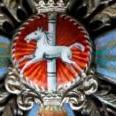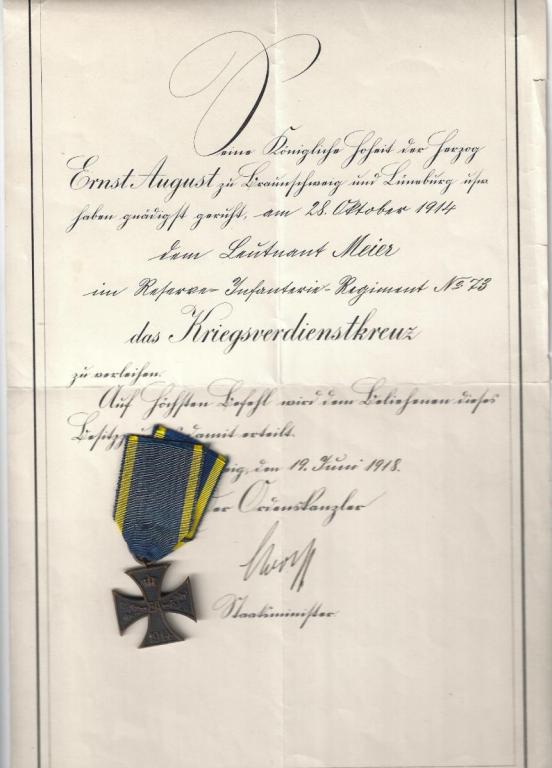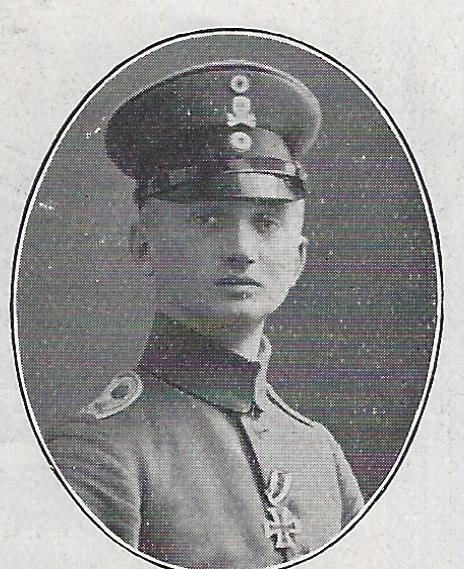-
Posts
511 -
Joined
-
Last visited
-
Days Won
10
Content Type
Profiles
Forums
Blogs
Gallery
Events
Store
Posts posted by BlackcowboyBS
-
-
-
Thanks, I guess I am tired, I haven't noticed that this was a knights cross, but now, sure makes sence!
0 -
Hi this is no order or medal but a identification disk of a police officer of the criminal investigation department. The tiny symbols are pure ornamentations as far as I can see.
1 -
wow, great stuff! But can somebody please explain to me, why there are swords on the star and none on the cross it self? Is this comon in Saxony? I knew the other way around in Brunswick. I am looking forward to reading your answers on this one.
0 -
I like it, do you have access to the German forum SDA? If not I can post your question there, if you don't mind and give you the answers here in English, if that is okay for you. Just let me know.
0 -
It is a nice little group. As you can see Franz Rust got his War Merit Cross awarded on 29. Deecember 1915 but his award certificate in January 1918, so nearly 2 years later. Thanks for showing.
0 -
1 hour ago, VtwinVince said:
Yes, nice early Urkunde. I find these FA documents interesting. I have a grouping with the Bewaehrungsabzeichen which I will have to find.
Yeah, I am looking forward to seeing it.
0 -
Hello, I would like to present you today a first very inconspicuous small estate, of which I do not know at all whether it is complete. The wounded badge is missing, whether other awards were present, I do not know.
We see here first the award certificate or recognition that Lieutenant Meyer of the Reserve Infantry Regiment No. 73 was awarded the Braunschweig War Merit Cross (at that time still one class) on October 28, 1914. Since this wartime award was not instituted until October 23, 1914, this is one of the very early awards. However, the young Duke of Brunswick, Ernst August, in his verve, had already issued awards of his new war decoration before, the first already on October 9, 1914. If you look more closely at the certificate, you will see that it itself was issued only on June 19, 1918! This is astonishing, but in a telephone conversation on October 24, Ernst August had informed the Order Chancellor Wolf of his decision that "the crosses ... would be sent after completion, the acknowledgments after the conclusion of peace". On November 27, 1915, this was revised and the acknowledgments for the war merit crosses on the fighter as well as on the peace ribbon were issued as of this date.
The certificate is 21x31 cm in size and thus corresponds to the early certificates, however, due to the general shortage of material, it was decided to halve the size of the certificate, only higher-ranking persons should still receive a certificate on a whole sheet. Whether the fact that Lieutenant Meier received his award already at the beginning of the war led to the fact that his recognition also took up a full page is not yet clear at the moment.
This small volume becomes very interesting by the fact that also the letter to the lieutenant Meier has been preserved, in which he was informed about the award of the cross. It states:
"Western theater of war, December 23, 1914.
To Herr Leutnant Meyer, 4th Comp Res. Infantry Regiment No. 73
Your Highness at Brunswick
By order of the Battalion I am sending the Ducal Brunswick War Cross of Merit, which His Royal Highness, the Duke of Brunswick, has awarded you.
I am pleased, dear comrade, to be able to present you with this award, which you have well deserved with the dedication of your own blood.
May the medal be a warm and friendly reminder for you of the time you spent with my company.
May God give you back your health. In faithful comradeship your devoted Schmubbe Captain and Company Leader".
One might wonder why Ltn. Meyer did not receive his cross until 2 months after the award, but the suppliers still needed time until the first war merit crosses arrived in Braunschweig. In the middle of November the first delivery arrived and until the crosses then landed with the troops, it also still took time. Therefore, this whole process is a good example of how it happened at that time in the Duchy of Brunswick and a first inconspicuous estate tells its part of the events of that time in the First World War.
PS: you may notice that the Name Meyer is miswritten on the offical reward document as Meier, but the recipient was Ltn Felix Meier that much is pretty clear.
0 -
4 hours ago, Eric Stahlhut said:
the hallmark is correct and is the first style--'St' is for stuttgart--
Thanks, there is allways something to learn here.
0 -
-
Is it a Cast? And what should KMS1 with the "1" mirror inverted should be? I have never seen this as a makers mark before, I am not an expert for Iron Crosses but I wouldn't buy it. Lets see what the experts say.
0 -
7 hours ago, Deutschritter said:
Oh yes, you really did. Thanks for that! May I ask, what the name of your book is and if it is in German?
Hey Deutschritter, sure you can ask. My books are written in German, you may have a look inside here and you can only order them directly at the publishing company. You can PN me, if you are interested then we can arrange it. Only 25 sets are left then it is sold out and no reprint is planned so far.
1 -
3 hours ago, Deutschritter said:
Great information, thank you! What I have always wanted to know, did the Ordenskanzlei use the decorations again, or were they saved in an archive? Thanks!
Normally the old orders were given back to the jeweller who supplied the Ordenzkanzlei, then the jeweller had to decide what to do, could the order be repaired with less effort than he would do so and the repaired order was awarded again. Is the order beyond repair he would melt it and use the gold or silver for other purposes. If the jeweller melted the old order, he gave the Ordenskanzlei a credit voucher for the next bill. The worth of old orders was written down in the treaty which the jeweller had signed with the Ordenskanzlei.
But if the returned orders did belonged to a very special and famous person, than it was kept. In my Book on the orders and medals of the Duchy of Brunswick I discribed the grand croos of the austrian emporer Franz Joseph which was returned in 1917. It was such a marvellous piece of art, that it was kept for the personal disposition of duke Ernst August. The grand cross set from GFM Moltke for example was kept and transferred to the Vaterländisches Museum where it still is.
I hope that this answers your question.
0 -
30 minutes ago, paul wood said:
dudosa
In German we have a saying: Es kommt mir spanisch vor, meaning it feels strange to me. Origin of this German idiom was the election of Karl V to be spanish King. The German noble men thought, when they saw him and his entourage: This looks spanish to me.
So to put in short words: Keep being suspicious.
0 -
Yes, it drives me crazy, no respect for history, all for the money. I hate it.
1 -
You can read about a reciepent of this cross here: Freiherr Grote
0 -
In issue 2 of the Iron Cross Magazine of 2019 there is a beautifully designed certificate on page 36 about the award of the Iron Cross 2nd Class to Lieutenant and Regimental Adjutant Günter Freiherr Grote. I have now found the same certificate in a magazine from 1919 and have scanned it for you.
I have found out the following about the certificate and the bearer:
The certificate was designed and drawn by Günther Clausen from Braunschweig, printed by the company E. Appelhans & Comp. (formerly Rud. Stolle & Gust. Rothelieb) also located in Braunschweig. The certificate has the dimensions of 25 x 27 cm.
Lieutenant Freiherr Grote (not to be confused with the wing adjutant of Duke Ernst August) was awarded the following decorations in WWI:
- Iron Cross 2nd Class
- Iron Cross 1st Class
- Brunswick War Merit Cross 2nd Class
- Brunswick Cross of War Merit 1st Class
- Mecklenburg-Strelitz Cross for Distinguished Service in War 2nd Class
There is an award of a Cross 4th Class HdL to Baron Hans Joachim Grote from 1909 (also a lieutenant in IR 92), but none to Günter Baron Grote. However, the two were probably related.
Since Günter Freiherr Grote was severely wounded on March 21, 1918, and succumbed to his injuries on April 6, 1918, his award of the Braunschweig KvK 1 must have been one of the very first. It is very doubtful whether he received the award at all. I would still like to show you his photo,
At least I don't know of any other EK2 certificate for IR 92 from Braunschweig designed in this way, do any of you know of any other examples?
1 -
Dr Ilberg got his knights cross 1st class of Henry the Lion Order from Brunswick at 27th october 1899. He handed it back 1908 because he was promoted to a commanders cross on 17th december of 1905. Dr. Ilberg died 8th july 1916 and his decoration was sent back in 1918.
1 -
This order is a beautyfull one, Thanks for sharing your knowledge with us.
0 -
17 hours ago, Chris Boonzaier said:
I wonder if he was a native of the Hansa Stadt?
Hi Chris,
no the Hanse Städte gave their hanseatic crosses even to soldiers and officers which are not born in a Hansestadt. If your commanding officer was from there or your fought in regiment with some relationship to the Hansestadt or you work in a military institution and did something well for the soldiers of that cites then you could get a hanseatic cross as well.
0 -
Ah, the Kgl. Niederländische Haushofmeister Lodder recieved his merit cross 1. class on 9th of may 1911 in Haag.
0 -
22 hours ago, GreyC said:
The colour of the ribbon seems dark blue. Would that point to a certain state? And wouldn´t his medals be listed in the Hannoversches Staatshandbuch or Kalender?
GreyC
Hi Graham,
you have been right about the ribbon, it is dark blue not black, as I have stated. I found an old placard from an exhibition in Hannover showing it much better. I am pretty convinced that this is not an official order but a bijou from a lodge. So does anyone has any clue?
0 -
Holy cow, that thing is a real beauty! never saw one before.
Congratulations on this one
0 -
Hello GreyC,
to my knowledge you don't find the orders in the Königl Groß-Britannisch und Chur-Fürstlich Braunschweig-Lüneburgisch Staatskalender, because it was not usual to do so in the 18th century. In the Kgl Hannovarian Staatskalender after 1815 you will find them, but even if Knigge had an official function as Oberhauptmann from 1790 on, you won't find him in these documents.
0









Fake or genuine badges?
in Germany: Weimar Republic & Deutsche Freikorps
Posted
You should first learn the difference between casts and embossing, very few medals were casted, so a cast is in 99.5 % a modern copy. Take this as a thumb of rule and you can save a lot of money.
In the next step you should learn to recognize a galvano and then you will even be better to tell the difference between originals and modern copies.
Andreas from medalnet can be the start in learning this:
Casts
Galvanos
The second post is in German but you might translate it with google translater to get the basic stuff out of it.